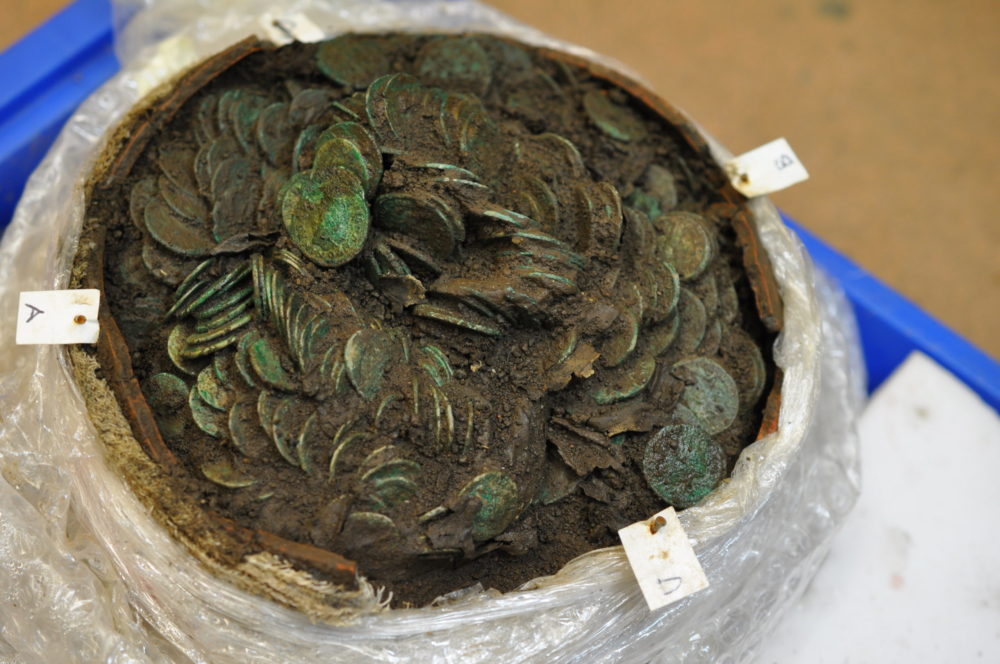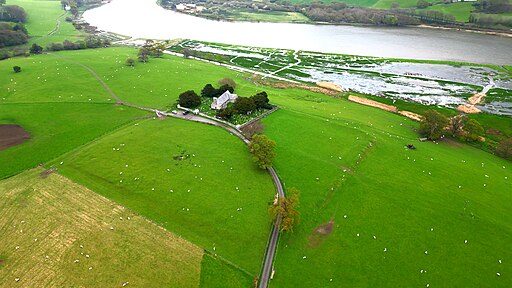Novice detectorists find Roman treasure in the Conwy Valley

The two Roman coin hoards discovered by metal-detectorists in the Conwy Valley have been declared treasure by the Assistant Coroner for North Wales (East & Central), Kate Robertson.
David Moss and Tom Taylor found the two hoards in Caerhun Community, Conwy, during the winter of 2018-2019.
The larger hoard (Treasure Case 19.01) was found in a ceramic vessel which contained 2,733 coins, a mix of silver denarii minted between 32 BC and AD 235, as well as silver and copper-alloy radiates (also known as antoniniani) struck between AD 215 and 270.
The copper-alloy coins appear to have been put loosely in the pot, but most of the silver coins were held in two leather bags, which were placed at the very top of the hoard.
The smaller hoard (Treasure Case 19.03) comprises 37 silver denarii, ranging in date from 32 BC to AD 221, which were found scattered across a small area in the immediate vicinity of the larger hoard.
Remembering an episode of the TV programme Time Team, when they discovered the larger hoard, they carefully excavated the pot, before wrapping it in bandages and reporting both hoards to Dr Susie White, Finds Officer for the Portable Antiquities Scheme in Wales (PAS Cymru) based at Wrexham County Borough Museum & Archives.
Huge surprise
David Moss said: “We had only just started metal-detecting when we made these totally unexpected finds. On the day of discovery, just before Christmas 2018, it was raining heavily, so I took a look at Tom and made my way across the field towards him to tell him to call it a day on the detecting, when all of a sudden, I accidentally clipped a deep object making a signal. It came as a huge surprise when I dug down and eventually revealed the top of the vessel that held the coins.”
“People do not realise the amount of work that goes on behind the scenes at the national museum, from excavating the coins, to looking after them and identifying them so they can be reported on as treasure……. it’s a huge process to be able to see the work unfold……to be involved at first hand as finders is an incredible experience.”
The hoards were then taken to Amgueddfa Cymru – Museum Wales for micro-excavation and identification.
Louise Mumford (Senior Conservator of Archaeology at Amgueddfa Cymru) said: “In the conservation lab, investigation at the top of the pot quickly revealed that some of the coins had been in bags made from extremely thin leather, traces of which remained. It is very rare for organic materials such as this to survive in the soil.
“The surviving fragments, which included two fragments of a stitched seam, were preserved and will provide information about the type of leather used and how the bags were made.”

TWI Technology Centre Wales in Port Talbot offered to CT-scan the larger hoard in the ceramic vessel, to see whether more information could be gleaned before extraction of the coins began.
Consultant engineer at TWI, Ian Nicholson, said: “Our main focus is to provide our services for industry. However, we also like to support non-industry projects and offer a wider benefit.
“Radiography was the only inspection technique that had the potential to volumetrically reveal the inside of the coin hoard without damaging it. Our state-of-the-art Computer Tomography inspection equipment uses high X-ray energy to penetrate thick metals, which is typically four times greater than the X-ray energies that dentists and hospitals use. We found the inspection challenge interesting and valuable when Amgueddfa Cymru – Museum Wales approached us – it was a nice change from inspecting aeroplane parts.
“Using our equipment, we were able to determine that there were coins at various locations in the bag. The coins were so densely packed in the centre of the pot that even our high radiation energies could not penetrate through the entire pot.
“Nevertheless, we could reveal some of the layout of the coins and confirm it wasn’t only the top of the pot where coins had been cached.”
3D models
The scan of the larger hoard found no evidence of further bags in the pot below the two visible at the top, and this proved to be correct as the pot was emptied. Along with the CT scans, a series of photographs and 3D models were created during the micro-excavation of the hoard. These will be used in further research, publications and displays.
Removing the coins in layers revealed that the older coins were generally closer to the bottom while the last coins of the hoard were found in the upper layers. The hoard was probably buried in AD 270 at a time when the Roman Empire was split between the Central Empire and the Gallic Empire, which included Britain.
The final coins in this hoard were issued during the reigns of Quintillus (AD 270) and Victorinus (AD 269-271).
Alastair Willis (Senior Curator: Numismatics and the Welsh Economy at Amgueddfa Cymru) said: “The coins in this hoard seem to have been collected over a long period of time. Most appear to have been put in the pot during the reigns of Postumus (AD 260-269) and Victorinus (AD 269-271), but the two bags of silver coins seem to have been collected much earlier during the early decades of the third century AD.”
The smaller hoard was probably buried in the AD 220s. The two hoards were found close to the remains of a Roman building which was excavated in 2013 and identified as a possible temple dating to the third century AD.

The discovery of these hoards supports this suggestion. It is very likely that the hoards were deposited here because of the religious significance of the site, perhaps as votive offerings, or for safe keeping under the protection of the temple’s deity. The coins may have belonged to soldiers at the nearby Roman fort of Canovium (located near Caerhun).
Llandudno Museum holds collections from Canovium fort and are keen to acquire these two important hoards with the support of Conwy Culture Centre and Amgueddfa Cymru.
Dawn Lancaster, Director of Amgueddfa Llandudno Museum, said: “This is very exciting news for Amgueddfa Llandudno Museum. The opportunity to purchase these important coin hoards which are associated with Kanovium Roman Fort will allow future generations to see and experience a significant collection of ancient silver coins dating from 32BC and representing 50 rulers.”
“Llandudno Museum holds all previous finds from the excavation of Kanovium Roman Fort sited at Caerhun in the Conwy valley, so it is fitting the hoard is put into context along with the rest of the artefacts. Working with Amgueddfa Cymru we can share the story of their discovery and the importance to Welsh cultural heritage of our area these amazing finds represent.”
Support our Nation today
For the price of a cup of coffee a month you can help us create an independent, not-for-profit, national news service for the people of Wales, by the people of Wales.







I guess this was after the destruction of the Decangli
I live on Anglesey and study roman history. There are many treasures that when found, go to Cardiff.and then mysteriously find there way across the border. The DECA as the Romans called the tribe of Anglesey. Actually did not get wiped out. When general agricola crossed in 77ad he Actually let the 2 celtic Lords keep the land. It was general paullinus in 60 ce that battled with the DECA because They frightened of the DRUID witchcraft. Danny roman
Won’t be long before it will be whisked away across the border.
Like everything found like this from Scotland Northern Ireland and Wales goes into old Museums in London
In other words they are still stealing anything they can het their hands on. In the event of independence throughout the UK will each nation get a fair share of all the treasures held in London or will it silently disappear on the day?